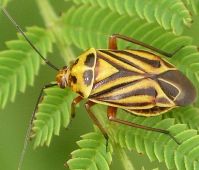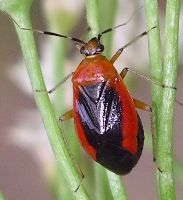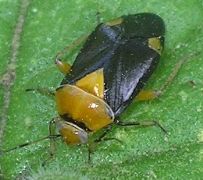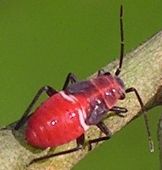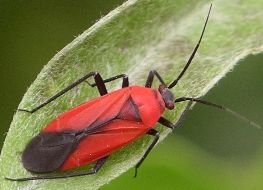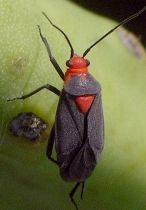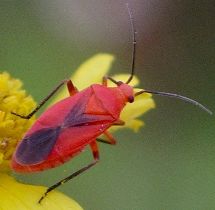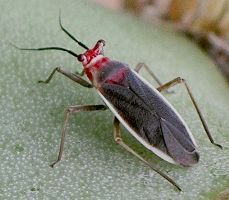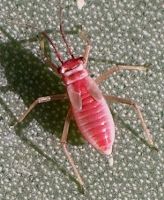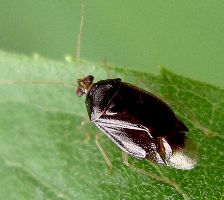
| Miridae ~ Plant Bugs |
page 1 ![]() page 2
page 2
|
The mirids constitute the largest family of true bugs. The majority feed on plants (a few are predatory) and some can be major pests. Because they feed by sucking out plant juices, they don't create ragged edges on leaves but instead cause leaves to discolor, shrivel, or have spots. Many plant bugs are not all that numerous and these do not cause problems, but when a population surges, then the damage to certain plant species, especially crops or ornamentals, can be substantial.
Plant bugs are on the small side, with the largest reaching only about 7 mm in length. The smallest that I've noticed are more like 3 mm or less. Most are about 5 mm. As a group, they are recognized by the presence of an obvious cuneus, or triangular patch at the rear of the thick part of the upper wing, and one or two rounded cells in the wing membrane, which are usually more obvious on one side than the other because the wings overlap each other. It often helps to note what kind of plant a mirid is feeding on, as a number of species are rather host-specific and there are databases with this information.
Some of the most often noticed mirids are, as would be expected, on the large side and also colorful. They resemble small beetles at a glance, especially the small and colorful leaf beetles. One of the prettiest mirids is the Four-lined Plant Bug (Poecilocapsus lineatus). It can also be quite a garden pest. The yellow color can also be light green, but the head is always orange, even on nymphs. This species feeds on a variety of plants, sometimes in large numbers. A similar looking insect is not so widespread but is quite common in our area. This is Calocoris barberi. It also has stripes and is usually yellow, but may also be a darker dull orange. It feeds mainly on Mexican Hat (Ratibida columnaris) but is sometimes found on the related coneflowers and Rudbeckia species. The image included here happens to be on a completely different plant in the legume family, but the insect shows up much better and they are often rather camouflaged on their usual host plant flowers.
Metriorhynchomiris dislocatus has an impossibly long name and no common moniker. It is just a little smaller than the previous species but has a similar shape. Although an all-black color variation can occur in this species, the ones in our area are all marked with gold, orange, or red. They are very shiny, almost looking like they are wet. The antennae are also distinctive, with black segments at the base and the last two outer segments being white.
A bit smaller than M. dislocatus, Neocapsus cuneatus has similar color variability. In this insect, though, the cuneus (triangular patch on the wing) is often, but not always, the contrasting color. It can also just be black. These are not as common as some plant bug species and I only see them occasionally.
There are other red and black mirids that have a similar body shape to Lopidea but they are not as flattened. This has been a challenging group to identify, even to the genus level, as there are not many labeled images available. I suspect a number of our species have restricted ranges and are not found by researchers elsewhere. Prepops has a red scutellum that is quite raised. It also has a red head but the rest of the body is a matte black.
A species in the genus Oncerometopus is yet another similar insect, with black markings on red. It is not particularly common. There is another species that might be in the same genus, or perhaps our single species is just quite variable. It is a mostly red bug, with wings that barely cover the abdomen. This could be because all I've seen are females, but it is quite noticeable that the abdomens are very rotund. These bugs show up in fields on flowers in the Compositae family. A very curious little bug feeds on prickly pear cactus in our area. Hesperolabops gelastops can often be found in great numbers on some plants. This mirid has a red head and black body with white borders. It is only about 5-6 mm in length. The odd thing about this bug is its stalked eyes. They stick up quite a bit above the head. Nymphs are red and their eyes only have short stalks.
Some bugs are not particularly common and only show up occasionally. A species in the genus Deraeocoris is one such insect. Its body is very dark brown with colorless antennae, legs and wing membrane. The body texture is shiny but with many fine punctures in the entire surface. It appears to have a relatively small head and constricted neck. |
page 1 ![]() page 2
page 2
![]()


